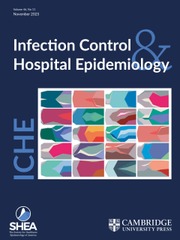Crossref Citations
This article has been cited by the following publications. This list is generated based on data provided by
Crossref.
Starke, Jeffrey R.
2001.
Transmission of mycobacterium tuberculosis to and from children and adolescents.
Seminars in Pediatric Infectious Diseases,
Vol. 12,
Issue. 2,
p.
115.
Iwata, Kentaro
Smith, Barbara A.
Santos, Eloisa
Polsky, Bruce
and
Sordillo, Emilia M.
2002.
Failure to Implement Respiratory Isolation: Why Does it Happen?.
Infection Control & Hospital Epidemiology,
Vol. 23,
Issue. 10,
p.
595.
Schwartzman, Kevin
2004.
Tuberculosis.
p.
855.
Settles, Gary S.
2006.
FLUID MECHANICS AND HOMELAND SECURITY.
Annual Review of Fluid Mechanics,
Vol. 38,
Issue. 1,
p.
87.
Humphreys, H.
2007.
Control and prevention of healthcare-associated tuberculosis: the role of respiratory isolation and personal respiratory protection.
Journal of Hospital Infection,
Vol. 66,
Issue. 1,
p.
1.
Qian, Hua
Li, Yuguo
Nielsen, Peter V.
and
Huang, Xinhua
2009.
Spatial distribution of infection risk of SARS transmission in a hospital ward.
Building and Environment,
Vol. 44,
Issue. 8,
p.
1651.
Ling, Daphne
and
Menzies, Dick
2010.
Occupation-Related Respiratory Infections Revisited.
Infectious Disease Clinics of North America,
Vol. 24,
Issue. 3,
p.
655.
Au, S.S.W.
Gomersall, C.D.
Leung, P.
and
Li, P.T.Y.
2010.
A randomised controlled pilot study to compare filtration factor of a novel non-fit-tested high-efficiency particulate air (HEPA) filtering facemask with a fit-tested N95 mask.
Journal of Hospital Infection,
Vol. 76,
Issue. 1,
p.
23.
Knibbs, Luke D.
Morawska, Lidia
Bell, Scott C.
and
Grzybowski, Piotr
2011.
Room ventilation and the risk of airborne infection transmission in 3 health care settings within a large teaching hospital.
American Journal of Infection Control,
Vol. 39,
Issue. 10,
p.
866.
Or, Peggy
Chung, Joanne
and
Wong, Thomas
2012.
Does Training in Performing a Fit Check Enhance N95 Respirator Efficacy?.
Workplace Health & Safety,
Vol. 60,
Issue. 12,
p.
511.
Pantelic, Jovan
and
Tham, Kwok Wai
2012.
Assessment of the mixing air delivery system ability to protect occupants from the airborne infectious disease transmission using Wells–Riley approach.
HVAC&R Research,
Vol. 18,
Issue. 4,
p.
562.
Fennelly, Kevin P
2020.
Particle sizes of infectious aerosols: implications for infection control.
The Lancet Respiratory Medicine,
Vol. 8,
Issue. 9,
p.
914.
Mat, Mohamad Nur Hidayat
Md. Basir, Md. Faisal
and
M. Yusup, Eliza
2021.
Fans deactivation for minimisation of airborne pathogen transmission: During Malaysians congregational prayer gathering in mosque.
International Communications in Heat and Mass Transfer,
Vol. 129,
Issue. ,
p.
105694.
Pavilonis, Brian
Ierardi, A. Michael
Levine, Leon
Mirer, Franklin
and
Kelvin, Elizabeth A.
2021.
Estimating aerosol transmission risk of SARS-CoV-2 in New York City public schools during reopening.
Environmental Research,
Vol. 195,
Issue. ,
p.
110805.
Mao, Yanhui
Ma, Jiale
Wang, Shengxu
Liang, Jiandong
and
Liang, Jianzhou
2022.
A stratum ventilation system for pollutants and an improved prediction model for infection in subway cars.
Atmospheric Pollution Research,
Vol. 13,
Issue. 3,
p.
101354.
Kakoulli, Christina
Kyriacou, Alexis
and
Michaelides, Michalis P.
2022.
A Review of Field Measurement Studies on Thermal Comfort, Indoor Air Quality and Virus Risk.
Atmosphere,
Vol. 13,
Issue. 2,
p.
191.
Duan, Yuqi
Cheng, Jun
Liu, Ying
Fang, Qidi
Sun, Minghao
Cheng, Chuanlong
Han, Chuang
and
Li, Xiujun
2022.
Epidemiological Characteristics and Spatial-Temporal Analysis of Tuberculosis at the County-Level in Shandong Province, China, 2016–2020.
Tropical Medicine and Infectious Disease,
Vol. 7,
Issue. 11,
p.
346.
Lu, Ying
Ou, Dexin
Zhou, Zhipeng
Li, Hongyang
Deng, Yongliang
Deng, Yunxuan
and
Zhang, Ziyao
2023.
Simulation analysis of passengers’ rescheduling strategies in metro station under COVID-19.
Tunnelling and Underground Space Technology,
Vol. 134,
Issue. ,
p.
105023.
Mo, Baichuan
Noursalehi, Peyman
Koutsopoulos, Haris N.
and
Zhao, Jinhua
2024.
Modeling virus transmission risks in commuting with emerging mobility services: A case study of COVID-19.
Travel Behaviour and Society,
Vol. 34,
Issue. ,
p.
100689.
Edwards, Alexander J.
King, Marco‐Felipe
Noakes, Catherine J.
Peckham, Daniel
and
López‐García, Martín
2024.
The Wells–Riley model revisited: Randomness, heterogeneity, and transient behaviours.
Risk Analysis,
Vol. 44,
Issue. 9,
p.
2125.

